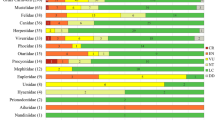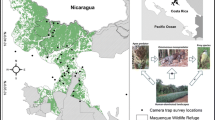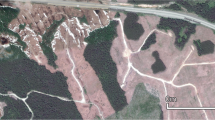Abstract
Conservation shortcuts such as umbrella species have been long used for regional protection of species whose distributions are poorly known. Although the European large carnivores—brown bear, gray wolf, and Eurasian lynx—might seem to be robust candidates as umbrella species, their actual effectiveness has been challenged. We used 10-km resolution distribution maps of mammals (n = 10) and birds (n = 55) of European conservation concern in the Romanian Carpathians, and a temporal sequence of land cover maps (1990, 2000, and 2006) to examine: (1) the spatial overlap in distribution between large carnivores and bird and mammal species of conservation concern, (2) changes in forest cover for the Romanian Carpathians during the post-communist period in relation to the distribution of species, and (3) priority conservation areas using carnivores as umbrella species. Approximately 55% of the bird and 80% of mammals species included in this study would potentially benefit from using large carnivores as conservation surrogates. The changes in forest cover during 1990–2006 were concentrated in the Eastern Carpathians, where up to 45% of the forest per mapping unit was clearcut during the study period. Implicitly, the areas of occupancy of the background species were most disturbed by clearcutting in the Eastern Carpathians. We propose that the large carnivores could act temporary as umbrella species in areas that are still relatively undisturbed, such as Southern and Southwestern Carpathians. This alternative conservation strategy will allow time for (1) the new established protected areas to start efficiently and (2) the forestry practices to switch from mostly uncontrolled clearcutting, lacking landscape scale management to ecologically-based practices.




Similar content being viewed by others
References
Andelman SJ, Fagan WF (2000) Umbrellas and flagships: efficient conservation surrogates or expensive mistakes? Proc Natl Acad Sci USA 97:5954–5959
Angelstam P, Mikusinski G (1994) Woodpecker assemblages in natural and managed boreal and hemiboreal forest—a review. Ann Zool Fenn 31:157–172
Anon (1979) Council Directive 79/409/EEC of 2 April 1979 on the conservation of wild birds. Council of the European Communities, Luxembourg
Anon (1992) Council Directive 92/43/EEC of 21 May 1992 on the conservation of natural habitats and of wild fauna and flora. Council of the European Communities, Luxembourg
Anon (2006a) Council Directive 2006/105/EC of 20 November 2006 adapting Directives 73/239/EEC, 74/557/EEC and 2002/83/EC in the field of environment, by reason of the accession of Bulgaria and Romania. Council of the European Communities, Luxembourg
Anon (2006b) Management and action plan for the Brown Bear population in Romania. Ministry of Environment and Water Management; Ministry of Agriculture, Forestry and Rural Development, Bucharest
Beier P, Majka DR, Spencer WD (2008) Forks in the road: choices in procedures for designing wildland linkages. Conserv Biol 22:836–851
BirdLife International (2004) Birds in Europe: population estimates trends and conservation status. BirdLife International, Cambridge
Biriş IA, Veen P (2005) Virgin forests in Romania. Inventory and strategy for sustainable management and protection of virgin forests in Romania. ICAS and KNNV, Bucharest. http://www.veenecology.nl/data/VirginforestRomaniaSummary.PDF. Accessed 02 Aug 2010
Boitani L (2000) Action Plan for the conservation of the Wolf in Europe. Convention on the Conservation of European Wildlife and Natural Habitats (Bern Convention). Nature and Environment Publishing, No. 113. Council of Europe Publishing, Luxembourg
Breitenmoser U, Breitenmoser-Würsten C, Okarma H et al (2000) Action Plan for the conservation of the Eurasian Lynx (Lynx lynx) in Europe. Convention on the Conservation of European Wildlife and Natural Habitats (Bern Convention). Nature and Environment Publication No. 112. Council of Europe Publishing, Luxembourg
Cabeza M, Arponen A, Van Teeffelen A (2008) Top predators: hot or not? A call for systematic assessment of biodiversity surrogates. J Appl Ecol 45:976–980
Caro TM (2003) Umbrella species: critique and lessons from East Africa. Anim Conserv 6:171–181
Caro TM (2010) Conservation by proxy: indicator, umbrella, keystone, flagship and other surrogate species. Island Press, Washington
Caro TM, O’Doherty G (1999) On the use of surrogate species in conservation biology. Conserv Biol 13:805–814
Ciochia V (1992) Păsările clocitoare din România. Editura Ştiinţifică, Bucureşti
Cogălniceanu D, Cogălniceanu GC (2010) An enlarged European Union challenges priority settings in conservation. Biodivers Conserv 19:1471–1483
Dalerum F, Somers MJ, Kunkel KE et al (2008) The potential for large carnivores to act as biodiversity surrogates in southern Africa. Biodivers Conserv 17:2939–2949
Day JW, Hall CA, Yanez-Arancibia A et al (2009) Ecology in times of scarcity. Bioscience 59:321–331
Favreau JM, Drew CA, Hess GR et al (2006) Recommendations for assessing the effectiveness of surrogate species approaches. Biodivers Conserv 15:3949–3969
Feranec J, Jaffrain G, Soukup T et al (2010) Determining changes and flows in European landscapes 1990–2000 using CORINE land cover data. Appl Geogr 30:19–35
Fleishman E, Blair RB, Murphy DD (2001) Empirical validation of a method for umbrella species selection. Ecol Appl 11:1489–1501
Fritts SH, Bangs EE, Gore JF (1994) The relationship of wolf recovery to habitat conservation and biodiversity in the northwestern United States. Landscape Urban Plan 28:23–32
Gòmez O, Milego R (2005) Corine land cover. How to analyze changes. European Environmental Agency, Copenhagen
Helle P, Järvinen O (1986) Population trends of North Finnish land birds in relation to their habitat selection and changes in forest structure. Oikos 46:107–115
Home R, Keller C, Nagel P et al (2009) Selection criteria for flagship species by conservation organizations. Environ Conserv 36:139–148
Hunter ML, Schmiegelow FA (2010) Wildlife, forests and forestry: principles of managing forests for biological diversity, 2nd edn. Prentice Hall, Upper Saddle River, NJ
Iojă IC, Pătroescu M, Rozylowicz L et al (2010) The efficacy of Romania’s protected areas network in conserving biodiversity. Biol Conserv 143:2468–2476
Iorgu O, Turtică M (2008) Certificarea FSC instrument şi consecinţă a managementului forestier responsabil. WWW Danube-Carphatian Programme, Braşov
IUCN (2010) Guidelines for using the IUCN red list categories and criteria. Version 8.1. Prepared by the Standards and Petitions Subcommittee in March 2010. Available from http://intranet.iucn.org/webfiles/doc/SSC/RedList/RedListGuidelines.pdf. Accessed 01 Dec 2010
Kuemmerle T, Muller D, Griffiths P, Rusu M (2009) Land use change in Southern Romania after the collapse of socialism. Reg Environ Change 9:1–12
Lackey RT (1998) Seven pillars of ecosystem management. Landscape Urban Plan 40:21–30
Lawler JJ, White D (2008) Assessing the mechanisms behind successful surrogates for biodiversity in conservation planning. Anim Conserv 11:270–280
Lindenmayer DB, Fischer J (2006) Habitat fragmentation and landscape change: an ecological and conservation synthesis. Island Press, Washington
Lindenmayer DB, Franklin JF (2002) Conserving forest biodiversity: a comprehensive multiscaled approach. Island Press, Washington
Linnell JDC (2001) Predators and people: conservation of large carnivores is possible at high human densities if management policy is favourable. Anim Conserv 4:345–349
Linnell JDC, Swenson JE, Andersen R (2000) Conservation of biodiversity in Scandinavian boreal forests: large carnivores as flagships, umbrellas, indicators, or keystones? Biodivers Conserv 9:857–868
Linnell JDC, Promberger C, Boitani L et al (2005) The linkage between conservation strategies for large carnivores and biodiversity: the view from the “half-full”forests of Europe. In: Ray JC et al (eds) Large carnivores and the conservation of biodiversity. Island Press, Washington
Mech DL, Boitani L (eds) (2003) Wolves: behaviour, ecology and conservation. The University of Chicago Press, Chicago and London
Mertens A, Promberger C (2001) Economic aspects of large carnivore-livestock conflicts in Romania. Ursus 12:173–180
Mikusinski G, Gromadzki M, Chylarecki P (2001) Woodpeckers as indicators of forest bird diversity. Conserv Biol 15:208–217
Munteanu D, Papadopol A, Weber P (2002) Atlasul păsărilor clocitoare din România. Societatea Ornitologică Română, Cluj Napoca
Murariu D (2000) Fauna României. Mammalia: Insectivora. Editura Academiei Române, Bucureşti
Murariu D (2004) Fauna României: Lagomorpha, Cetacea, Artiodactyla, Perissodactyla (fără specii actuale). Editura Academiei Române, Bucureşti
Murariu D, Munteanu D (2005) Fauna României: Carnivora. Editura Academiei Române, Bucureşti
Niedzialkowska M, Jedrzejewski W, Myslajek RW, Nowak S et al (2006) Environmental correlates of Eurasian lynx occurrence in Poland—large scale census and GIS mapping. Biol Conserv 133:63–69
Noss RF, Quigley HB, Hornocker MG et al (1996) Conservation biology and carnivore conservation in the Rocky Mountains. Conserv Biol 10:949–963
Ord JK, Getis A (1995) Local spatial autocorrelation statistics: distributional issues and an application. Geogr Analys 27:286–306
Pătroescu M (1987) Succesiunea zonelor şi etajelor de vegetaţie din R.S. România. In: Velcea V (ed) Sinteze geografice. Tipografia Universităţii din Bucureşti, Bucureşti
Pătroescu M, Iojă IC, Pătroescu-Klotz I et al (2006) Umweltqualitat in Rumanien. In: Kahl T, Metzeltin M, Ungureanu R (eds) Rumänien Raum und Bevölkerung. Geschichte und Geschichtsbilder.Kultur. Gesellschaft und Politik heute. Wirtschaft. Recht undVerfassung. Historische Regionen. LIT Verlag, Münster-Hamburg-Berlin-Wien-London-Zürich
Popescu A, Murariu D (2001) Fauna României. Mammalia: Rodentia.Editura Academiei Române, Bucureşti
Primack RB, Pătroescu M, Rozylowicz L et al (2008) Fundamentele conservării diversităţii biologice. AGIR, Bucureşti
Ray JC (2005) Large carnivorous animals as tools for conserving biodiversity: assumptions and uncertainties. In: Ray JC et al (eds) Large carnivores and the conservation of biodiversity. Island Press, Washington
Rey V, Groza O, Ianoş I et al (2007) Atlas de la Roumanie. Reclus, Montpelier, Paris
Roberge JM, Angelstam P (2004) Usefulness of the umbrella species concept as a conservation tool. Conserv Biol 18:76–85
Roberge JM, Mikusinski G, Svensson S (2008) The white-backed woodpecker: umbrella species for forest conservation planning? Biodivers Conserv 17:2479–2494
Rowland MM, Wisdom MJ, Suring LH et al (2006) Greater sage-grouse as an umbrella species for sagebrush-associated vertebrates. Biol Conserv 129:323–335
Rozylowicz L, Chiriac S, Sandu RM et al (2010) The habitat selection of a female lynx (Lynx lynx) in the northwestern part of the Vrancea Mountains, Romania. North-West J Zool 6:122–127
Salvatori V, Okarma H, Ionescu O et al (2002) Hunting legislation in the Carpathian Mountains: implications for the conservation and management of large carnivores. Wildlife Biol 8:3–10
Samonil P, Antolik L, Svoboda M et al (2009) Dynamics of windthrow events in a natural fir-beech forest in the Carpathian mountains. Forest Ecol Manag 257:1148–1156
Schelhaas MJ, Nabuurs GJ, Schuck A (2003) Natural disturbances in the European forests in the 19th and 20th centuries. Glob Change Biol 9:1620–1633
Schmiegelow FKA, Machtans CS, Hannon SJ (1997) Are boreal birds resilient to forest fragmentation? An experimental study of short-term community responses. Ecology 78:1914–1932
Seddon PJ, Leech T (2008) Conservation short cut, or long and winding road? A critique of umbrella species criteria. Oryx 42:240–245
Sergio F, Caro T, Brown D et al (2008) Top predators as conservation tools: ecological rationale, assumptions, and efficacy. Annu Rev Ecol Syst 39:1–19
Seymour RS, Hunter ML (1998) Principles of ecological forestry. In: Hunter ML (ed) Maintaining biodiversity in forest ecosystems. Cambridge University Press, Cambridge
Sillero-Zubiri C, Laurenson KM (2001) Interactions between carnivores and local communities: conflicts or co-existence? In: Gittleman JL, Funk SM, Macdonald D et al (eds) Carnivore conservation, vol 5 carnivore biology. Cambridge University Press, Cambridge
Simberloff D (1998) Flagships, umbrellas, and keystones: is single-species management passe in the landscape era? Biol Conserv 83:247–257
Soulé ME (1985) What is conservation biology? Bioscience 35:727–734
Swenson JE, Gerstl N, Zedrosser BDA (2000) Action Plan for the conservation of the Brown Bear (Ursus arctos) in Europe. Convention on the Conservation of European Wildlife and Natural Habitats (Bern Convention). Nature and Environment Publication No. 114. Council of Europe Publishing, Luxembourg
Temple HJ, Terry A (eds) (2007) The status and distribution of European mammals. Office for Official Publications of the European Communities, Luxembourg
Toader T, Dumitru I (2005) Romanian forests. National Parks and Natural Parks, Romsilva, Bucharest
Treves A (2009) Hunting for large carnivore conservation. J Appl Ecol 46:1350–1356
Ulanova NG (2000) The effects of windthrow on forests at different spatial scales: a review. Forest Ecol Manag 135:155–167
Valenciuc N (2002) Fauna României. Mammalia: Chiroptera. Editura Academiei Române, Bucureşti
van Maanen E, Predoiu G, Klaver R et al (2005) Safeguarding the Romanian Carpathian Ecological Network. A vision for large carnivores and biodiversity in Eastern Europe. A&W Ecological Consultants, Braşov
Veen P, Fanta J, Raev I et al (2010) Virgin forests in Romania and Bulgaria: results of two national inventory projects and their implications for protection. Biodivers Conserv 19:1805–1819
Virkkala R, Rajasarkka A, Vaisanen RA et al (1994) Conservation value of nature reserves—do hole-nesting birds prefer protected forests in Southern Finland. Ann Zool Fenn 31:173–186
Zar JH (2010) Biostatistical analysis, 5th edn. Pearson Prentice Hall, Upper Saddle River, NJ
Acknowledgments
We would like to thank Richard B. Primack, Malcolm L. Hunter and two anonymous reviewers whose comments greatly improved this manuscript.
Author information
Authors and Affiliations
Corresponding author
Additional information
Laurenţiu Rozylowicz and Viorel D. Popescu contributed equally to this research.
Rights and permissions
About this article
Cite this article
Rozylowicz, L., Popescu, V.D., Pătroescu, M. et al. The potential of large carnivores as conservation surrogates in the Romanian Carpathians. Biodivers Conserv 20, 561–579 (2011). https://doi.org/10.1007/s10531-010-9967-x
Received:
Accepted:
Published:
Issue Date:
DOI: https://doi.org/10.1007/s10531-010-9967-x




